What is a Safe Following Distance Between Two Vehicles?
According to the Maryland Department of Transportation, drivers should always maintain a safe distance between his or her vehicle and the one in front. This is because a majority of rear-end collisions are caused by following too closely behind another vehicle. A minimum of three to four seconds of following distance is recommended during ideal driving conditions.
What is an At-Fault Accident State?
Maryland is an at-fault state for car accidents. This means that drivers are allowed to sue for financial compensation after a crash where another driver is responsible for injuries and damages to personal property. Insurance companies will investigate the crash to determine fault. Often, insurance claims of this nature result in proceeding to a lawsuit where the court will determine fault.
Compensation will only be paid to the driver who is determined to be not at fault for the accident.
What is Contributory Negligence?
Maryland is one of four states that are contributory negligence states. This means that if a driver is found to hold any responsibility at all for an accident, then the driver may be barred from collecting any compensation awarded in the case. Due to this rigid stipulation, it is crucial to retain representation as soon as possible with Tehrani Law, LLC. In many cases, only one driver is solely at fault.
What are Common Scenarios Resulting in a Rear-End Collision?
Rear-end collisions may occur via the following scenarios:
- Failing to slow down when traffic stops for a red light
- Failing to slow down for a car preparing to make a turn
- Foggy conditions that obstruct views
- Loss of control on snow or ice-covered roads
- Hitting broken or stopped vehicles on the shoulder
- Failing to slow down for slower traffic in construction zones
- Hitting vehicles merging at intersections
- Hitting vehicles merging from a ramp
- Falling asleep at the wheel
- Distracted driving
- Tailgating
- A vehicle breaking down on the road
- An unexpected merge onto the highway
- Reversing into traffic
Are You Automatically at Fault if You Rear-End Someone in Maryland?
It is largely assumed that the driver who rear-ends another car is automatically at fault for the injuries and damage sustained to the other vehicle and its occupants. While that is not always the case, it may be tricky to prove that the driver in the back was not even partially responsible. Common causes of rear-end collisions where the second driver is at fault through distracted driving are as follows:
- A cell phone
- A child in the vehicle
- The radio or dash console
- Another passenger
- Eating or drinking while driving
- Manipulating car system settings
- Reading a map or operating a navigational system
- Checking road signs
- Looking at the wrong traffic signal
- Attempting a lane change
- Tailgating
- Any other distraction
When is a Driver Not At Fault When Rear-Ending Another Vehicle?
Drivers are not automatically at fault for a rear-end collision in the following circumstances:
- A driver suddenly reverses
- A driver slows down suddenly or unexpectedly without working brake lights
- A driver stops suddenly to turn and fails to make the turn or without signaling properly
- A driver with a flat tire fails to pull over or put on vehicle hazard lights
- A driver pulls in front of another vehicle from a side road without yielding
- A drunk driver slams on the brakes for no apparent reason
What Common Injuries are Sustained in Rear-End Collisions?
Common injuries that occur in rear-end collisions are as follows:
- Back injuries
- Broken bones
- Bruises
- Facial injuries, including dental injuries and other facial disfigurement
- Head trauma from striking an object inside the vehicle
- Knee and leg injuries from striking the console
- Loss of limbs
- Paralysis
- Other soft tissue injuries and damage
- Spinal cord and neck injuries
- Traumatic brain injuries
- Whiplash
What Damages May Be Recovered?
During a successful rear-end collision trial, the victim may be entitled to financial compensation in the form of economic and non-economic damages. In some cases, a victim may be able to recover additional compensation for punitive damages. Examples of economic damages include lost wages, property damage, medical bills, future medical expenses, and lost earning ability.
Examples of non-economic damages include pain and suffering, pre-impact fright, inconvenience, loss of spousal companionship, mental anguish, and wrongful death.
What Accident Settlement is Expected?
Settlements are commonly recovered in rear-end collision cases due to liability typically being proven. However, it is important to note that insurance companies in Maryland will fight the victim on how much compensation should be received for their injuries. For this reason, a skilled lawyer is relied on to fight the insurance companies on behalf of the injured party.
What Should I Do Following a Rear-End Collision?
Taking the right steps following any type of automobile accident is crucial for any legal proceedings that may occur. Those steps are as follows:
- Do not admit fault: Never apologize at the crash site. The insurance company may view an apology as an admission of fault.
- Call first responders: Calling 911 enables all parties to receive medical attention. This is important to do even if no injuries are obvious.
- Document evidence of damages: Taking pictures of property and personal damage will present a clear trail of events that led to the accident. Other evidence that is beneficial is the contact information of all parties involved and witnesses present.
- File a police report: a police report should be initiated once law enforcement arrives at the scene. This report is vital in acknowledging the accident and creating a timeline for the events.
Do I Need An Attorney?
The most important way to protect yourself in a rear-end collision is by securing legal representation. Call Tehrani Law, LLC, today at 301-778-2294 or fill out a contact form for a free consultation.

 301-973-6510
301-973-6510 Email Us Now
Email Us Now




